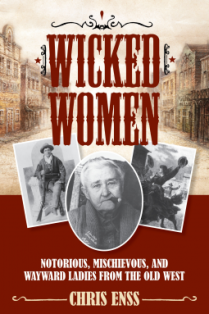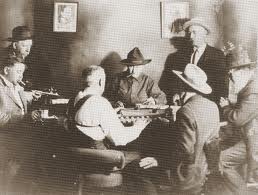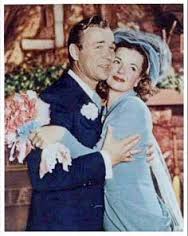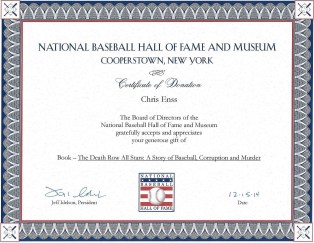1881 – Michael O’Rourke, also known as Johnny Behind the Duce, killed Phillips Schneider at Charleston, Arizona.
Good Run of Bad Luck
Take a chance. Enter now to win a copy of the new book
Wicked Women: Notorious, Mischievous, and Wayward Ladies from the Old West.
Polite society in the 1800s referred to women who owned and operated their own gambling dens as “wicked.” But America’s oldest diversion deteriorated into a vice without the help of lady gamblers. In the turn of a card or the roll of a dice for all or nothing, there was a kind of daring that touched the American spirit. “The lust for work is matched…by the lust to gamble.” The affluent risked thousands in comfort; the poor risked bread money on gaming tables in slum taverns.
The gambling fever produced two opposing species. First were the predatory card sharps and confidence men and women who understood human weakness and how to exploit it; second were the masses, eternally gullible to the lure of something for nothing. Throughout the nation these adversaries met – in lotteries, over tables, at racetracks, in casinos, cockpits – and the result was nearly always the same. The suckers lost.
In 1870, San Francisco had an estimated 2,500 gambling houses, which produced as they did elsewhere, crime and degradation. And while these are hardly the by-products one would expect of a leisure activity, it should be remembered that vice can become a pastime for people who had little alternative resources.
To learn more about the wicked women on the wild frontier read
Wicked Women: Notorious, Mischievous, and Wayward Ladies from the Old West.
National Book Launch on February 21, 2015.
An Excerpt from Wicked Women: Notorious, Mischievous, and Wayward Ladies From the Old West

Julia Bulette, Siren of the Silver Town
“Every city in the civilized world must have its soiled doves. It is a necessary evil.”
Bakersfield Californian – October 25, 1892
The cold, grey January sky above Virginia City, Nevada, in 1867 unleashed a torrent of sleet on a slow moving funeral procession traveling along the main thoroughfare of town. Several members of the volunteer fire department, Virginia Engine Company Number One, was first in a long line of mourners following after a horse drawn carriage transporting the body of soiled dove Julia Bulette. The Nevada militia band shuffled behind the hearse playing “The Girl I Left Behind Me.” Black wreaths and streamers hung from the balconies of the buildings along the route which the remains of the beloved thirty-five-year-old woman was escorted. Miners who knew Julia wept openly. Out of respect for the deceased woman all the saloons were closed. Plummeting temperatures and icy winds eventually drove the majority of funeral-goers inside their homes and businesses before Julia was lowered into the ground.
Julia Bulette was murdered on January 19, 1867 at 11:30 in the evening in her home on North D Street in Virginia City. The fair but frail prostitute told her neighbor and best friend Gertrude Holmes she was expecting company, but did not specify who the company might be. Twelve hours later Gertrude discovered Julia’s lifeless body in bed. She had been beaten and strangled. Gertrude told authorities that Julia was lying in the center of the bed with the blankets pulled over her head and that the sheets under her frame were smooth. She told police that it appeared as though no one had ever been in the bed with Julia.
The authorities believed the scene had been staged. Marks on Julia’s body and tears on the pillow used to smother her indicated she struggled with her attacker. The murderer then set the room to look as though nothing was out of the ordinary. He covered Julia’s body in such a way that at a passing glance she would merely appear to be asleep. It had fooled the handyman she had employed to come in and build a fire for her each day. When the gentleman entered Julia’s home at eleven in the morning he believed she was sleeping. He explained to law enforcement officers that he was quiet as he went about his work and left when the job was done. A search of the modest home Julia rented revealed that many of her possessions were missing. The citizens of Virginia City were outraged by the crime.
Julia Bulette was born in London, England, in 1832. She arrived in Virginia City, Nevada in 1863. Men in the bustling, silver mining community supported a number of sporting women, and Julia was no exception. She was an independent contractor. She did not work as a madam of a house of ill repute managing other women in the trade. She had a number of regular customers including Thomas Peasley. Peasley owned a local saloon and was known to be Julia’s favorite paramour. In addition to running a business, Peasley was a volunteer firefighter. Julia’s interest in the Virginia Engine Company Number One began with him. She supported them monetarily when she could and cheered them on whenever they were called to a job. In recognition of her service she was presented with a handsome feminine rendition of a fireman’s uniform. It consisted of a fireman’s shield, front shirt, belt and helmet embossed with the insignia of Virginia Engine Company Number One. Julia was the only woman who was an honorary member of the volunteer force.
The murder of the well-liked courtesan baffled many. She owned a few beautiful gowns but did not have an extensive wardrobe; nor did she have any jewelry of great worth. The home where she lived was furnished with items of good quality but was not overly opulent. Julia’s estate was worth $875.43. She owed more than $790 in unpaid bills including $291 in legal fees and an outstanding balance for alcohol she kept on hand for her customers. She generally served whiskey and brandy but had bottles of ale, port, claret, and rum available as well.
An auction of Julia’s belongings was held on March 28, 1868. Her friend, Mary J. Minnivie was the administrator of her estate and provided a list of the deceased personal property. It consisted of the following: one blue, plaid, silk dress; one red, meire antique dress and bodice; a black silk, dress, one purple dress, one silk cap rimmed with fur, one blue flannel shirt, one silver cup marked J.C.B., one pair red silk stockings, three chemises, one white silk chord, four handkerchiefs, one pair of gloves, one brown silk necktie, one fur cape, one fur collar, four fur muffs, one purple hood, one porte-monnaie (a small pocket book or purse), one gold hunting watch, gold chain and charms, one watch case, one jet-set breast pin, earrings and cross, and one silver brick marked Julia.
The sale of Julia’s things did not cover all she owed when she died. Her creditors would have to settle for whatever they were given toward the unpaid bills.
Virginia City police conducted an intense search for Julia’s murderer, but four months after her body had been discovered authorities still had no leads. It appeared as though the unknown assailant had fled the area and any hope of ever finding the perpetrator had ended. According to the November 9, 1955, edition of the Reno Gazette, it wasn’t until Mrs. Cazentre, wife of the owner of a small restaurant in Gold Hill, Nevada, stumbled upon a clue to the crime that turned around the police investigation.
In April 1867, Mrs. Cazentre was looking over a fine piece of silk she was going to use to make a dress when two customers came into the restaurant for breakfast, sat down at a table and began talking. Their discussion centered on Julia Bulette’s brutal murder and the failure of the authorities to find her killer. Mrs. Cazentre overheard the customers mention that the murderer was believed to have stolen two pieces of silk dress material from his victim. Mrs. Cazentre was astonished. A few months prior to this occasion she had purchased material from a drifter for an incredibly modest price. When she bought the fabric, Mrs. Cazentre asked the salesman how he came to have such a fine piece of material, and the man told her it had once belonged to a lady whose husband had been killed in a mining accident.
After Mrs. Cazentre finished speaking with the two customers she hurried out of the restaurant to the courthouse with the material in tow. She shared everything that had transpired with Judge Jesse S. Pitzer. He then summoned Harry and Sam Rosner, owners of a local mercantile called Rosner and Company, who identified Mrs. Cazentre’s silk as the material sold to Julia Bulette. Judge Pitzer then suggested that Mrs. Cazentre view all the drifters, vagabonds and thugs currently in jail for vagrancy to see if the man who sold her the silk might be among them. It turned out the salesman was indeed incarcerated at the city jail and Mrs. Cazentre quickly identified him.
The culprit was a Frenchman named John Millian who had been employed at a bakery in town. In March 1867, Millian had attempted to attack one of Julia Bulette’s neighbors. He had broken into the neighbor’s home carrying a knife. When the woman screamed he had run. The neighbor had reported the attack to the police and led them through Virginia City in search of Millian. He had been arrested trying to leave town. After Mrs. Cazentre identified Milian within his jail cell, authorities examined a trunk Millian’s employer said belonged to him that was stored at the bakery. The trunk was full of Julia Bulette’s possessions. Once he was presented with the evidence against him, Millian confessed to the crime. He withdrew his confession shortly after his trial began on July 2, 1867.
According to Alfred Doten, editor of the Gold Hill News, the court proceedings “created great excitement in the city.” A myriad of witnesses were called to the stand to testify against Millian including Mrs. Cazentre who told her story about the material; the proprietors of Rosner and Company explained the fabric was purchased at their store, and Gertrude Holmes identified Julia’s belongings found in Millian’s trunk.
Charles Dlong, a Virginia City attorney and one time California State Assemblyman represented Millian. He argued that his client did not murder Julia. He claimed she was killed by two other men and that Millian was asked to store the possessions for them. Millian told the court he did not know the names of the actual killers and could not produce witnesses to support his claim. The case was handed over to the jury eight hours after opening statements had been made. They found Millian guilty of murder and he was sentenced to be hanged. All attempts for appeals were denied. On April 24, 1868 Millian was taken from the jail and loaded aboard a carriage. Surrounded by the National Guard and armed deputies, he was driven to the gallows a mile outside town.
According to the June 9, 1868, edition of the Janesville Gazette, so many had gathered to watch the hanging it was difficult for the carriage to make it down the street. “Only by scolding, pushing and threatening with a bayonet was there enough room to proceed,” the article read. “The road to the gallows was lined on either side with men, women and children, all striving with open mouths and distended eyes to catch a glimpse of the prisoner. A way in advance, as far as the eye could see a mob of men, women and children were hurrying along the road, over the hills, and across lots and fields in the direction of the spot fixed upon for the execution.
“It was a motley crowd: white women with children in their arms, Piute squaws with young ones upon their backs, long-tailed and wide-eyed Chinese men, women of the town and women evidently from the country, with men of all kinds and colors. Here was calculated a crowd of not less than three thousand persons.
“Although he wore a somewhat haggard look from his long confinement, yet Millian showed he possessed nerves of steel. He read his manuscript which was quite lengthy, in a loud and clear voice, and held the paper so firmly in his hands that not the slightest tremor was observable. Having finished reading, he spoke for some two to three minutes in the French language, when he turned about and shook hands with the sheriff and kissed the reverend fathers. He then stepped to the front of the scaffold and, in very good English said, ‘Mr. Hall and family, I am very much obliged to you for your services, and also to the kind ladies that visited me in my cell.’
“Two young men of the Hall family then went upon the scaffold and shook hands with him. His arms and legs were now firmly pinioned, himself taking off his slippers and otherwise assisting, his collar opened and the fatal noose adjusted around his neck by the under Sheriff. He took one last look at the noose as it was brought forward, then stood while it was being properly placed, with his eyes downcast and his lips moving as though uttering a prayer.
“The black cap was now pulled down over his face, and on the instant the under Sheriff detached the fastening of the trap, and the body of Millian disappeared through the scaffold. He fell between six and seven feet and was doubtless killed instantly, as his neck was dislocated.”
Sagebrush and erosion have almost obscured the spot at Flower Hill Cemetery believed to be the last resting place of Julia Bulette. An old-fashioned “cradle-type” marker, the wooden enclosure has a reddish tint due to weathering. Nobody ever recorded where exactly Julia was buried. The proper citizens of Virginia City preferred to forget it.
Good to be Bad
It’s a wicked giveaway. Enter now to win a copy of the new book
Wicked Women: Notorious, Mischievous, and Wayward Ladies from the Old West.
Early review of Wicked Women from NetGalley.com. When one thinks of the Wild American West, one likely thinks of names like Wyatt Earp, Doc Holliday and Wild Bill Hickock. Only slightly less remembered are names like Calamity Jane and Big Nose Kate. In most saloons across the Western States women called many of the shots at the card tables and many ran the brothels as Madams. In Chris Enss’ new book, Wicked Women: Notorious, Mischievous and Wayward Ladies from the Old West the tales of some of the most scandalous women of the day come forward to take their place at the table.
Enss compiles tales from San Francisco to Deadwood, and all the places in between. Women like Squirrel Tooth Alice (named for her pet prairie dogs), Tessie Walls and Belle Cora lead houses of ill repute and gambling better than any man of their day. What they all seemed to succumb to was the love of a wicked man. Many of the women started out as mothers and homemakers, only to be left completely alone when their man skipped out on them or died at the hands of the law. These women took matters into their own hands, and by doing so their incomes.
Enss’ writing is comprehensive, as well as sympathetic. While she never hides the crimes of these women, she does tell of them in an entertaining way that finds the reader nose deep in the book and unable to turn away. It is difficult to put down Wicked Women and even more difficult not to talk to those around you about it.
Wicked Women: Notorious, Mischievous and Wayward Ladies from the Old West is a delightful look into the Old American West for those who want to read a history that isn’t just menfolk at the OK Corral.
To learn more about the wicked women on the wild frontier read
Wicked Women: Notorious, Mischievous, and Wayward Ladies from the Old West.
National Book Launch on February 21, 2015.
This Day…
Bad to the Bone
Something wicked is on the way. Enter now to win a copy of the new book
Wicked Women: Notorious, Mischievous, and Wayward Ladies from the Old West.
“A man dressed in overalls and heavy shoes, with faded hat and bony hands are not to be feared unless he is drunk. Such a man will not steal and will work if he has work to do. It is the slick gentlemanly sneak, who tries to dress well, smokes cigarettes and opium, gambles when he has a stake, associates with soiled doves by day, living off their shameful earnings, and burglarizing residence by night. A proper distribution of muscle and a little birdshot would be the best treatment for such depraved men and their wicked women.”
The Daily Californian – October 29, 1882
To learn more about the wicked women on the wild frontier read
Wicked Women: Notorious, Mischievous, and Wayward Ladies from the Old West.
National Book Launch on February 21, 2015.
And the Winners Are…
This Day…
1881 – Yuba County Stage from Camptonville robbed at Bridgeport where a covered wooden bridge spanned the South Fort of the Yuba River, north of Smartsville. Wells Fargo reported express box and mail pouches taken, but losses to the express company and to mail customers were unknown. Black Bart strikes again.
King of the Cowboys Marries Queen of the West
Last chance to enter to win a copy of The Cowboy and the Senorita:
A Biography of Roy Rogers and Dale Evans and
Happy Trails: A Pictorial Celebration of the Life and Times of
Roy Rogers and Dale Evans.
In the fall of 1947 Roy proposed to Dale as he sat on Trigger. The pair was performing at a rode in Chicago, and moments before their big entrance Roy suggested they get married. The date set for the wedding was New Year’s Eve. Gossip columnists predicted that Trigger would be the best man and that Dale would wear a red-sequined, cowgirl gown. The prediction proved to be false.
Roy and Dale’s wedding was a simple affair held at a ranch in Oklahoma, which happened to be the location for the filming of their seventeenth movie, Home in Oklahoma. The couple’s agent, Art Rush, served as best man and his wife, Mary Jo, was the matron of honor.
To learn more about Roy Rogers, Dale Evans, and Trigger enter to win now and Happy Trails.






